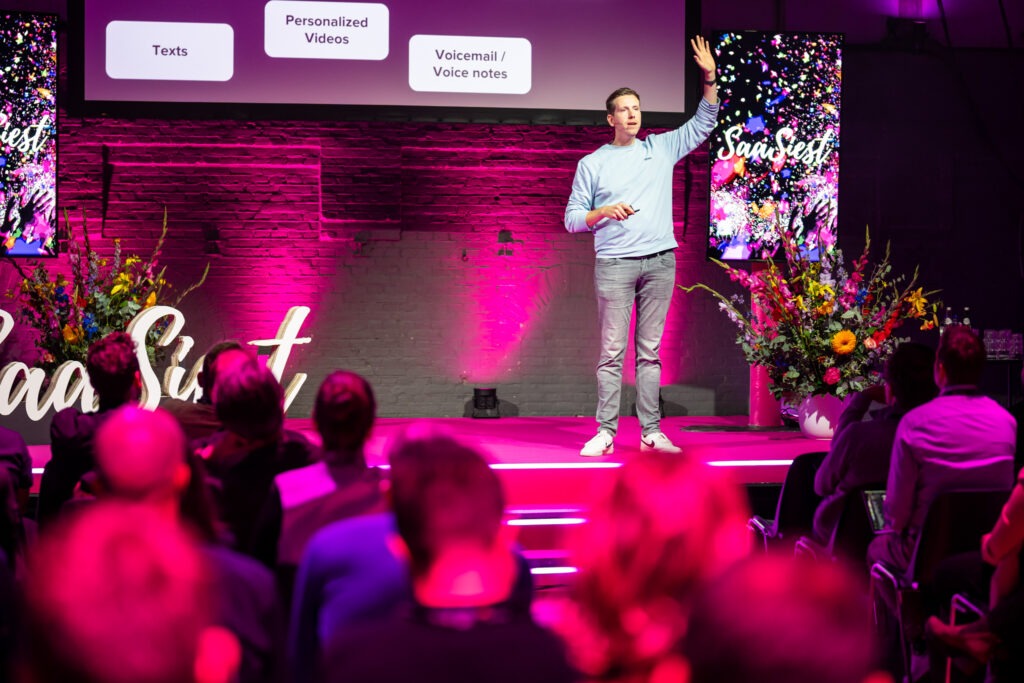
Buyers today are rewriting the B2B playbook, and sales teams are catching up to keep pace. Koen Stam, Head of Benelux at Personio, digs into a striking reality: only 17% of the buyer’s journey is spent engaging with vendors. The rest? It’s a solo journey, where buyers are researching, comparing, and deciding independently.
In this landscape, traditional sales tactics fall flat. Koen’s solution? Asynchronous communication – a method that empowers sales teams to reach buyers when they’re ready, not just when they’re available for a meeting. From personalized video messages to interactive digital sales rooms, Koen’s approach challenges the status quo and invites sales teams to adapt to buyers’ new behaviors. Here’s a breakdown of Koen’s insights on how to transform sales strategies and forge deeper connections in this new, buyer-led world.
The buyer’s journey is changing
In today’s B2B world, buyers are spending less time in direct contact with vendors. Koen Stam, Head of Benelux at Personio, highlights that a striking 83% of the buyer’s journey is now devoted to self-guided research and comparison, leaving minimal time for vendor interactions. B2B buying is becoming increasingly complex and they’re doing more of their homework online, which means they’re engaging with sales teams less frequently.
For sales teams, this means each interaction needs to be high-impact, offering unique insights, value, and a memorable experience. In a landscape where buyers often prefer to chart their own path, vendors must adapt to support this journey thoughtfully, even with fewer direct engagements.
Rethinking the sales process for today’s buyer
The traditional, linear B2B sales process no longer aligns with how modern buyers make decisions. Buyers now navigate an unpredictable path, moving between research, evaluation, and decision stages in a non-linear fashion. This can involve revisiting information or taking additional time to research before making a final choice.
Koen argues that it’s essential for sales teams to adjust to this shift: “Are we adapting to the new ways buyers want to engage? It’s not about the hard sell anymore. We need to be able to add value asynchronously and let buyers explore on their terms.”
Embracing asynchronous communication tactics
Let’s walk you through five key async communication tactics that enable vendors to better align with the buyer’s journey. Async communication is more than just a set of tools – it’s a strategy to foster trust, add value, and nurture buyer relationships without forcing them into real-time conversations.
Tactic 1: Async messaging on LinkedIn
Connecting with buyers early and consistently is essential. A proactive approach by connecting with potential customers on LinkedIn and engaging through thoughtful comments and direct messaging here is crucial. “Who is connecting with their buyers consistently?” he asks. “Building those connections early can help establish rapport long before the buying decision is made.”
Additionally, engaging with buyers’ content on LinkedIn, through comments or reactions, can create touchpoints that build familiarity and trust.
Tactic 2: Video personalization
Personalized video messages, whether for prospecting or updating buyers mid-cycle, are an effective way to communicate asynchronously. Koen shares an example of how his team sends personalized video messages for specific updates. “It’s as simple as sending a quick video update after a meeting,” he says. “It adds a personal touch and shows we’re truly invested in their success.”
In one case, his team recorded a video detailing how Personio’s payroll solutions could address an accounting firm’s unique needs. These types of personalized videos help keep the buyer engaged and informed, and can often reach other stakeholders within their organization, enhancing internal alignment.
Tactic 3: Multi-threading with stakeholders
Koen stresses the importance of multi-threaded communication with all stakeholders in the buying process. Rather than sending a general thank-you message after a demo, sales reps should follow up with personalized notes for each attendee, addressing their unique concerns. “We need to build multiple connections within an organization so that if one person leaves, the relationship doesn’t disappear with them,” he explains.
He provides an example of how a well-timed video message from a product director helped win over a skeptical interim HR leader at a competing firm, ultimately turning them into a champion for Personio.
Tactic 4: Pre-recorded Demos
Pre-recorded demos empower buyers to explore products on their own terms, setting the stage for more impactful conversations. By sending tailored demos ahead of live discussions, sales teams give prospects the freedom to dive in at their own pace and come prepared with specific questions. This approach maximizes each interaction, making future engagements more strategic and productive.
“They let buyers experience our product without the pressure of a live meeting, offering the flexibility to review when it suits them,” Koen explains.
Tactic 5: Digital sales rooms
Perhaps the ultimate async tactic, digital sales rooms provide a centralized space where buyers can access resources, share feedback, and follow the sales process in real time. These rooms allow vendors to monitor buyer interactions with content and adjust their approach based on insights gained.
Koen explains, “It’s not about pushing the buyer through our process. It’s about guiding them through their journey and co-creating an action plan.” He points out that digital sales rooms offer an invaluable way to foster collaboration with buyers, particularly those new to purchasing software, by providing a structured yet flexible buying experience.
The future of B2B sales is asynchronous
Asynchronous communication is emerging as a cornerstone for B2B sales, aligning perfectly with the autonomy that modern buyers crave. By integrating async tactics—such as pre-recorded demos and digital sales rooms, organizations can deliver information on the buyer’s terms, enhancing engagement without the pressure of constant live meetings.
Adopting async strategies not only builds trust but also positions sales teams to stand out from competitors and meet evolving buyer expectations. Those who adapt to this shift are poised to thrive in 2024 and beyond, transforming buyer interactions into meaningful, high-impact engagements that drive long-term success.